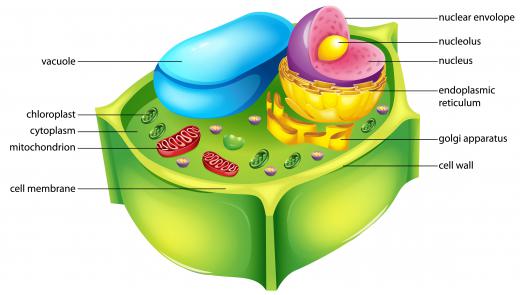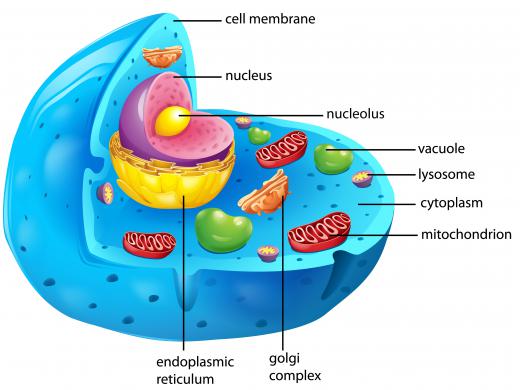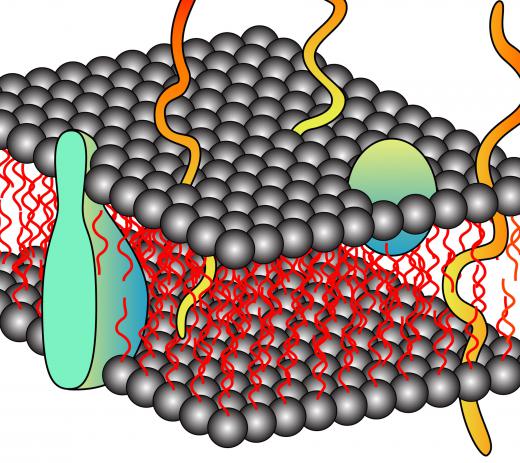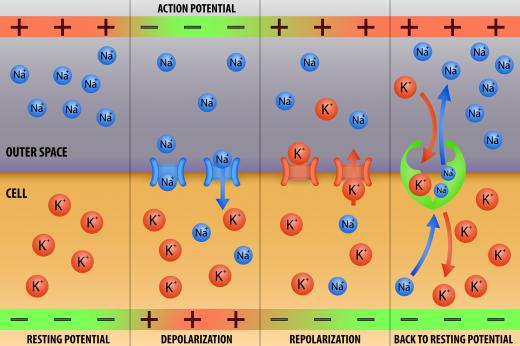What is Resting Membrane Potential?
Resting membrane potential is the difference in voltage of the fluids inside a cell and outside a cell, which is usually between -70 to -80 millivolts (mV). All cells have this difference, but it is particularly important in relation to nerve and muscle cells, since any stimulus that changes the voltage and makes it different from the resting membrane potential is what allows the cells to transmit electrical signals. If the cells didn't have the voltage difference, then they would be neutral, and wouldn't transmit any information.
Background

All cells have a membrane that serves as a barrier between the fluid outside of them and that inside, and to control what types of particles can go in and out of the cell. Some particles, like oxygen, can go through the membrane on their own, but other larger ones need special channels to get through. Some of these channels only let one type of particle in and out, and don't actively push or pull the particles in any direction, while others can take multiple types of particles, and can actively push them in or out of the cell. Both types can be open or closed at specific times by the cell to control the flow of particles.
Resting Potential

When a cell is resting, the fluid inside of it is a little bit more negative than the fluid outside of it, which generally has a charge of 0 mV. This is because of electrically charged particles called ions. The ions that cause the difference in voltage are the type of particles that need channels to get through the membrane, and include things like potassium (K+), and sodium (Na+). When a cell is at rest, it contains a concentration of large negative ions inside it, as well as some K+ and a little bit of Na+. The outside of the cell is surrounded by Na+ and a little bit of K+, among other things.

Since fluids ideally want to have different types of particles dispersed evenly throughout them, the K+ inside the cell wants to go outside of it and the Na+ wants to come inside, so that there ions would be evenly distributed. They can't do this though, because the channels that allow Na+ to pass through the membrane are closed when the cell is at rest, and those for K+ are just slightly open, which only lets a little bit of K+ leak out. Additionally, there is a third type of channel that actively pushes any extra Na+ out of the cell and takes any K+ that leaks out back into it. This means that the slightly negative voltage inside the cell is maintained, creating the resting membrane potential.
Action Potentials

An action potential is the way that cells transmit electrical information, and happens in response to a stimulus. If a cell that's at rest receives enough of a stimulus to get the charge of the fluid inside it up to -55 mV, then the channels that let Na+ through open up, causing a lot of Na+ to flow into the cell. This further raises the charge of the fluid inside, up to about +30 mV. Once the fluid reaches this charge, the Na+ channels close and the K+ channels open all the way, letting K+ flow out of the cell. It takes longer for these channels to open than the Na+ channels though, so the cell fluid remains positively charged for a little bit.
Refractory Period
Once the K+ channels are fully open, then a lot of K+ flows out of the cell, bringing its internal voltage down to about -90 mV. This is called hyperpolarization, and keeps the stimulus from coming back and affecting the same cell again, since the fluid is now at a much lower voltage, which means that a much greater stimulus would be needed to get it back up to -55 mV. After this happens, then the channels that take in K+ and push out Na+ start working, and eventually move the cell back to the resting membrane potential of -70 mV.
AS FEATURED ON:
AS FEATURED ON:














Discussion Comments
The downward phase after a climax in action is caused by hyperpolarization, during which chemicals interact in a way to cause an undershoot, which is the low tangent at the refractory period. This is also known as the afterhyperpolarization period.
@ShadowGenius
The refractory period is also used to describe sexual potency. It is the time after orgasm during which another orgasm cannot be attained. Living organisms require time to recover from actions such as these, forming a tangent in actions.
The refractory period is the time after a peak action potential has been attained, during which resting membrane potential is low. This is a rest period during which an organism is recovering from its recent action and cannot perform it again for a short while.
Very informative article.
Post your comments